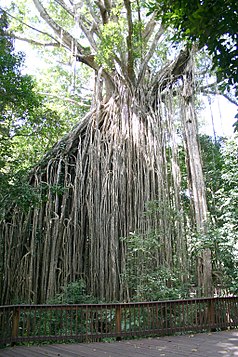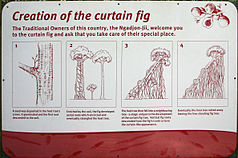Curtain Fig National Park
| Curtain Fig National Park | ||
|---|---|---|
| Curtain - strangling fig ( Curtain Fig Tree ) | ||
|
|
||
| Location: | Queensland , Australia | |
| Specialty: | Strangler fig | |
| Next city: | 2 km from Yungaburra | |
| Surface: | 1.96 km² | |
| Founding: | 2005 | |
| Creation of the curtain Fig | ||
| Size comparison of strangler fig roots | ||
The Curtain Fig National Park (English Curtain Fig National Park ) is a 2 km² national park in Queensland , Australia . Since 1988 it has been listed as a UNESCO World Heritage Site Wet Tropics of Queensland because of its natural beauty, biological diversity , evolutionary history and as a habitat for numerous endangered animal species . Its landmark is the looking like a curtain strangling fig (English: Curtain Fig Tree ).
Location and access
The park is located in the Atherton Tablelands and is approximately 45 km southwest of Cairns and 60 km northwest of Innisfail . About 1 km southwest of Yungaburra branches off the Gillies Highway from Fig Tree Boulevard , which leads directly into the national park.
geology
The park landscape was shaped by volcanoes in the period from 10,000 ( Pleistocene ) to 2 million years ago ( Pliocene ). The volcanic rock eroded and formed fertile basalt soils on which the forest grew. The soils contain abundant traces of phosphates and calcium , and abundant rainfall of 1300 to 1600 mm per year ensure optimal growth conditions. The floors of the two parks are interspersed with boulders, so they cannot be used for agriculture.
Creation of the Curtain Fig Tree
The Curtain Fig Tree is a strangler fig of the species Ficus virens . Usually these plants germinate in the canopy of other trees and then form roots to reach the ground. When this important step is taken, the fig will grow faster, the aerial roots will become thicker and interlinked. After hundreds of years, they eventually kill the host tree, which is slowly rotting away. The fig can now continue to grow on its own. In the case of the Curtain Fig, the host tree tilted during this process so that the aerial roots, up to 15 meters long, grew as a curtain towards the ground. The strangler fig is 50 m high, has a trunk circumference of 39 m and is estimated to be 500 years old.
Even though this species of fig kills its host, they are still epiphytes that get nutrients from the soil. In contrast to parasites that tap into the host's plant sap.
Web links
- Official site of the park (English)
Individual evidence
- ↑ a b c Official Park Website - Culture , Queensland Parks and Wildlife Service , accessed October 7, 2012
- ↑ a b Official Park Website - About , Queensland Parks and Wildlife Service , accessed October 7, 2012
- ^ Wet Tropics parks , Queensland Parks and Wildlife Service , accessed October 7, 2012



